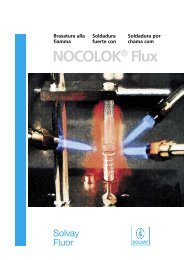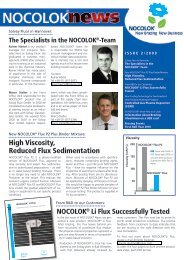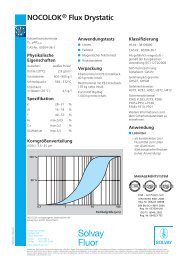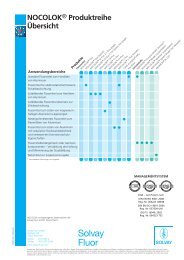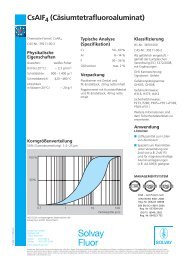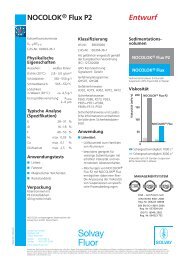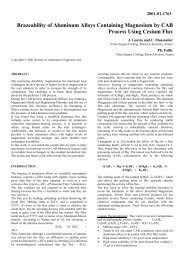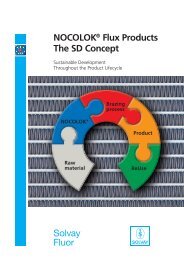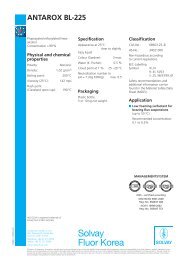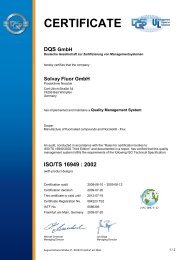NOCOLOK® Cs Flux - Aluminium Brazing Blog
NOCOLOK® Cs Flux - Aluminium Brazing Blog
NOCOLOK® Cs Flux - Aluminium Brazing Blog
Create successful ePaper yourself
Turn your PDF publications into a flip-book with our unique Google optimized e-Paper software.
Compatibility of Refrigerant R134a and PAG Oil in the<br />
Presence of Post-Braze <strong>Flux</strong> Residue from Cesium-<br />
Containing <strong>Flux</strong>es (NOCOLOK ® <strong>Cs</strong> <strong>Flux</strong>)<br />
Martin Schwiegel, Christoph Meurer, Hans-Walter Swidersky<br />
Solvay Fluor und Derivate GmbH & Co. KG, Hanover (Germany)<br />
Daniel C. Lauzon, Solvay Fluorides, Inc., St. Louis, MO (USA)<br />
ABSTRACT<br />
This paper summarizes and evaluates compatibility tests of the refrigerant Solkane ®<br />
134a and polyalkylene glycol lubricant (PAG oil) with post-braze flux residue<br />
from cesium-containing non-corrosive fluxes (NOCOLOK ® <strong>Cs</strong> <strong>Flux</strong>).<br />
NOCOLOK ® <strong>Cs</strong> <strong>Flux</strong> contains 2% cesium. It can be used for all aluminum brazing applications<br />
(e. g., controlled atmosphere or furnace brazing [CAB], flame brazing, and -induction<br />
brazing). The cesium-containing flux allows to braze aluminum alloys with a slightly higher<br />
magnesium content (i.e. up to 0.6 – 0.8%).<br />
Several tests were performed to research possible interactions between cesium-containing<br />
flux residue and other substances present in a common residential A/C system. The work<br />
focused on potential interactions of flux residue with R134a refrigerant and the lubricant<br />
(PAG oil for R134a units). Main objectives were to exclude flux residue as a potential<br />
source for malfunctions of automotive A/C systems operating on R134a, and to establish<br />
scientific evidence for the stability of the refrigerant/ lubricant system in the presence of<br />
cesium flux residue.<br />
The equipment design for these tests resembled an automotive A/C unit with a CABbrazed<br />
aluminum heat exchanger. Each of the tests ran for approximately 500 h, followed<br />
by a detailed analysis of all system components.<br />
This work adequately proved the stability of mixtures containing R134a and PAG oil in the<br />
presence of flux residue from cesium-containing flux. It was also confirmed that cesiumflux<br />
residue generated by flame brazing processes shows no effect on the lubricant and<br />
the refrigerant.<br />
1. INTRODUCTION<br />
Since NOCOLOK ® <strong>Flux</strong> brazed heat exchangers are in use with R134a/ PAG oil,<br />
questions of system stability and potential chemical interactions are of concern.<br />
Most of these heat exchangers are used in automotive A/C systems. Over the last<br />
few years, Solvay carried out a research project to identify any adverse interactions<br />
between the flux, the refrigerant and the lubricant [1] – [5].<br />
This research program was the basis for further tests: a) stability of R407C with<br />
POE lubricant in presence of standard NOCOLOK ® <strong>Flux</strong> [6], and b) stability of<br />
R134a with PAG lubricant in presence of NOCOLOK ® <strong>Cs</strong> <strong>Flux</strong> [this paper].<br />
2003 International Invitational Aluminum <strong>Brazing</strong> Seminar
2. SCOPE<br />
The test program described in figure 1 was carried out to study interactions of<br />
NOCOLOK ® <strong>Cs</strong> <strong>Flux</strong> residue in refrigeration and A/C systems operating with R134a<br />
and PAG oil.<br />
Scope of test<br />
program<br />
R<br />
Standard NOCOLOK <strong>Flux</strong> = HX<br />
R<br />
Standard NOCOLOK <strong>Flux</strong> = HX<br />
Standard NOCOLOK <strong>Flux</strong> = HX<br />
R<br />
NOCOLOK <strong>Cs</strong> <strong>Flux</strong> =<br />
Brazed Samples, Powder<br />
Standard NOCOLOK <strong>Flux</strong> = HX<br />
R<br />
NOCOLOK <strong>Cs</strong> <strong>Flux</strong> =<br />
Brazed Samples, Powder<br />
Figure 1: Test Program:<br />
Compatibility of NOCOLOK ® <strong>Cs</strong> <strong>Flux</strong> in refrigerating<br />
systems operating on R134a and PAG oil<br />
All experiments were realized in a test rig that was previously used for the above<br />
mentioned stability tests of the couples R134a/ PAG oil and R407C/ POE lubricant<br />
in the presence of post-braze flux residue from standard NOCOLOK ® <strong>Flux</strong>. The<br />
program consisted of four test cycles (test 0 – test 3) with gradually deteriorating<br />
operating conditions, up to the point in which a much higher amount of moisture<br />
was intentionally added to the system than normally accepted.<br />
Sufficient proof for the compatibility of NOCOLOK ® <strong>Cs</strong> <strong>Flux</strong> with the R134a refrigerant<br />
and PAG oil is established, when during the worst case scenario (test 3), no<br />
notable influence of NOCOLOK ® <strong>Cs</strong> <strong>Flux</strong> residue on the system is detected, particularly<br />
not on the refrigerant/ lubricant mixture.<br />
Based on the positive results of the referenced tests, it was decided to shorten the<br />
scope and to start with test 2.<br />
R<br />
R<br />
2003 International Invitational Aluminum <strong>Brazing</strong> Seminar
3. EXPERIMENTS<br />
3.1. TEST APPARATUS<br />
A flow chart of the test rig is illustrated in figure 2:<br />
Sample<br />
F2a<br />
F3a<br />
F2<br />
F2b<br />
F3<br />
F3b<br />
F2c<br />
F3c<br />
Filter<br />
Dryer<br />
Automotive<br />
Condenser<br />
Expansion valve<br />
Evaporator<br />
Compressor<br />
Figure 2: Schematic illustration of the system used for<br />
post-braze flux residue compatibility tests<br />
Only a limited range of materials was selected for constructing the test rig. Besides<br />
sealing materials (mostly Teflon and paper sealing of the compressor), the entire<br />
system only consisted of Stainless Steel for the pipes, and aluminum for the<br />
evaporator as well as the condenser. These choices of component materials minimized<br />
the parameters potentially influencing the test results and thus reduced possible<br />
sources of problems.<br />
The test section consisting of the filter and a sample vessel (see figure 2) was located<br />
in the liquid line. A combination of wire mesh- and dry powdered Stainless<br />
Steel was used as filter element. After the test, the filters were analyzed as indicators<br />
of chemical reactions or corrosion effects caused by the refrigerant/ lubricant/<br />
NOCOLOK ® <strong>Cs</strong> <strong>Flux</strong> mixtures.<br />
In front and behind of the sample vessel, a series of filters – consisting each of<br />
one 40 micron filter followed by three parallel 15 micron filters – was placed sequential<br />
with the refrigerant flow. A new set of filter elements was build into this<br />
section for each test – to ensure comparable conditions.<br />
2003 International Invitational Aluminum <strong>Brazing</strong> Seminar<br />
F1<br />
Filter<br />
M<br />
Frequency<br />
Changer
Cleaning Procedure:<br />
Prior to all experiments, the complete installation was thoroughly cleaned for two<br />
days by rinsing with propane 2-ol using a standardized procedure as described in<br />
[2].<br />
3.2. ANALYTICAL METHODS<br />
Refrigerant Analysis<br />
Gas chromatography (GC) was used for the refrigerant analysis.<br />
Lubricant Analysis<br />
All lubricant samples were analyzed by the manufacturer [7]. PAG oil with a viscosity<br />
class of 46 was used for the tests.<br />
The following parameters were characterized:<br />
• Viscosity at 40°C – in [mm²/ s]<br />
• Water content (by Karl-Fischer-Analysis) – in [mg/ kg]<br />
• Acidity – in [mg KOH/ g]<br />
• Trace impurities (by ICP) – in [mg/ kg]<br />
Gravimetrical Analysis<br />
The angle-on-coupon samples (see chapter 3.3), which were introduced in the<br />
sample vessel (figure 2) during test 2 and 3, were weighed before and after the<br />
tests (each coupon three times) to determine erosion or corrosion potentially initiated<br />
by exposure to the refrigerant/ lubricant mixture. The scale precision was<br />
± 0.1 mg.<br />
REM/ WDX – XRD Analysis<br />
Before each test, the eight filter elements (see chapter 3.1) before and after the<br />
sample vessel, and the filter behind the compressor (in the high pressure part of<br />
the installation), were replaced with fresh units. These filter elements and the furnace-brazed<br />
samples, as well as some selected components (e.g. tubes) of the test<br />
rig were analyzed by scanning electron microscopy in connection with a wave dispersive<br />
x-ray scan (REM/WDX). Through this method, chemical elements on the<br />
sample surfaces can be characterized to identify potential corrosion effects.<br />
Optical Analysis<br />
To further determine corrosion or other chemical reactions of the installation, all<br />
tubes, vessels and parts of the compressor were visually examined. Photographic<br />
documentation of the internal tube surfaces was performed before and after the<br />
tests, using a macro lens with endoscopes.<br />
Light microscope photos were also taken of the valve plate in the compressor.<br />
2003 International Invitational Aluminum <strong>Brazing</strong> Seminar
3.3. SAMPLE PREPARATION<br />
Angle-on-coupon Samples:<br />
For tests 2 and 3, each 45 aluminum angle-to-coupon specimens were prepared as<br />
samples with NOCOLOK ® <strong>Cs</strong> <strong>Flux</strong>. <strong>Brazing</strong> took place in a laboratory glass tube<br />
furnace – to generate joints similar to those in the standard manufacturing process<br />
for aluminum heat exchangers. A schematic illustration of the aluminum angle-tocoupons<br />
is shown in figure 3.<br />
Figure 3: Angle-on-coupon samples (top view and side view)<br />
Dimensions and materials for the angle-on-coupon samples were as follows:<br />
• Aluminum coupon Size: 25 x 25 x 0.4 mm<br />
• Base material: AA 3003<br />
• Clad material: 10% AA 4343 (7.5% Si)<br />
• Angle: Size: 40 x 5 x 0.5 mm, with 45° angle<br />
• Material: 99.5 % Al<br />
• <strong>Flux</strong> coating: 5 g/ m²<br />
• Heating rate 30°C/ min<br />
• <strong>Brazing</strong>: 600°C<br />
40 of the 45 coupons were introduced in the sample vessel on different levels. The<br />
remaining five coupons were used as a reference after the tests. The preparation<br />
of the angles-on-coupon samples is described in detail in [3].<br />
Mechanically detached NOCOLOK ® <strong>Cs</strong> <strong>Flux</strong> residue<br />
Additional NOCOLOK ® <strong>Cs</strong> <strong>Flux</strong> residue powder from a flame brazing experiment<br />
was obtained for the stability tests 2 and 3 – by mechanical removal from the joint<br />
areas after brazing. This residue was then incorporated into the sample vessel together<br />
with the coupons.<br />
The following materials were used to prepare NOCOLOK ® <strong>Cs</strong> <strong>Flux</strong> residue powder:<br />
• Aluminum sheet - base material AA 3003<br />
• Thickness: 1.5 mm<br />
• Clad material: 10% AA 4343 (7.5% Si)<br />
• <strong>Flux</strong> coating: > 10 g/ m²<br />
• <strong>Brazing</strong>: 600°C for 2 minutes<br />
2003 International Invitational Aluminum <strong>Brazing</strong> Seminar
This additional NOCOLOK ® <strong>Cs</strong> <strong>Flux</strong> residue powder should maximize any potential<br />
interactions between the flux and the refrigerant and/ or the lubricant. The presence<br />
of powder in the system increased the residue surface area in direct contact<br />
with the refrigerant/ lubricant mixture. The quantity of NOCOLOK ® <strong>Cs</strong> <strong>Flux</strong> residue<br />
powder placed into the sample vessel was about 0.5 g – each, for test 2 and 3.<br />
3.4. TEST CYCLES<br />
Worst case test (no. 2)<br />
Based to the program as outlined in figure 1, a worst-case-test was performed for<br />
500 h. Before the test, the installation was cleaned with propane 2-ol (see point<br />
3.1 and [2]). 40 angle-on-coupon specimens were placed with 0.5 g NOCOLOK ® <strong>Cs</strong><br />
<strong>Flux</strong> residue into the sample vessel on different levels (see point 3.3). The sample<br />
vessel was located in the liquid line of the A/C cycle (figure 2).<br />
Before and after the test, all coupons were cleaned in a propane-2-ol-ultrasonicbath<br />
and weighed (see point 3.2: gravimetrical analysis). The mean value of the<br />
total weight of all angle-on-coupons placed into the sample vessel was 38.2531 g.<br />
After the test, no signs of corrosion could be found in the filter elements. Only a<br />
few loose NOCOLOK ® <strong>Cs</strong> <strong>Flux</strong> residue grains were located in the pores.<br />
The mean value of the total weight of all angle-on-coupons of test 2 (after cleaning)<br />
was 38.274 g – an increase of + 0.0209 g. No further optical surface analysis<br />
of the coupons was carried out after the test.<br />
The lubricant exhibited a slightly higher neutralization number and water content.<br />
However, all values were still within acceptable ranges.<br />
Accelerated worst case test (no. 3):<br />
The conditions of the last test were comparable with test no. 2, except for some<br />
distilled water that was injected into the cycle. The injected quantity represented a<br />
water content of 500 ppm in correlation with the combined weight of refrigerant<br />
and lubricant. 0.5 g of NOCOLOK ® <strong>Cs</strong> <strong>Flux</strong> residue and 40 angle-on-coupons were<br />
placed in the sample vessel of the liquid line. The experiment then ran for 500 h.<br />
The mean value of the total weight of all angle-on-coupons added to the vessel in<br />
test 3 was 38,1403 g.<br />
After this period, neither on the filter elements nor in the tubes or on the compressor<br />
valve plate any corrosion was observed.<br />
The refrigerant analysis revealed no degradation. GC-analysis of the refrigerant<br />
sample showed a small but negligible increase of the impurities R143a and R125,<br />
when compared with the analysis of the original material.<br />
A lubricant sample was analyzed by ICP for trace element contaminations (Pb, Fe,<br />
Zn, Si, Al, Cu, Cr, Sn, Ag, Mg, Ni, Mo, Na, Ca, P, Ba, B, Mn, Ti, and Li). No impuri-<br />
2003 International Invitational Aluminum <strong>Brazing</strong> Seminar
ties were found. Consequently, it could be concluded that the compressor revealed<br />
no signs of abrasion during this test cycle.<br />
The infrared (IR) spectra of the lubricant indicated some contamination with water<br />
(as could be expected) and minimal ester traces. For this lubricant sample no tests<br />
for viscosity-at-40°C, neutralization-number, and water-content were performed.<br />
The optical analysis of the angle-on-coupon surfaces showed an unchanged top<br />
(i.e. surface with flux residue and brazed angle) when compared to the reference<br />
coupons (figure 4). The coupon bottom was rougher when compared with the reference<br />
(figure 5). The mean value of the total weight of all angle-on-coupons of<br />
test 3 was 38.1534 g – an increase of + 0.0131 g.<br />
All other components of the test rig showed no changes.<br />
3.5. TEST CYCLES – ANALYTICAL RESULTS<br />
Lubricant analysis of test 2 and 3:<br />
Both lubricant samples of test 2 and 3 showed no significant impurities. The water<br />
content and the neutralization number of test 2 are slightly higher but still within<br />
acceptable ranges. Viscosity at 40°C, water content and the neutralization number<br />
of test 3 were not analyzed (see chapter 3.4: Accelerated worst case test – no. 3).<br />
Table 1: Oil-analysis realized by the lubricant manufacturer:<br />
Units Test 2: Test 3:<br />
Viscosity at 40°C mm 2 / s 58.78 not analyzed<br />
Acidity mg KOH/ g 0.11 not analyzed<br />
H2O (Karl Fischer) mg/ kg 285 not analyzed<br />
ICP-Elements mg/ kg not detectable not detectable<br />
Weight analysis of the angle-on-coupon samples of test 2 and 3:<br />
Table 2: Weight analysis of angle-on-coupon samples:<br />
Total – before test [g]: Total – after test [g]: Difference [g]:<br />
Test 2: 38.2531 38.2740 + 0.0209<br />
Test 3: 38.1403 38.1534 + 0.0131<br />
The measuring precision of the balance was ± 0.0001 g. After test 2, the average<br />
weight difference for one coupon was about + 0.0005 g. After test 3, just as in<br />
test 2, a slight coupon weight increase was detected. The average weight difference<br />
for one coupon in test 3 was about + 0.0003 g.<br />
GC-analysis of the refrigerant samples after each test:<br />
Results for the GC-analysis of test 2 and 3 can be found in table 3. All samples<br />
were taken from the liquid line after the installation was switched off.<br />
2003 International Invitational Aluminum <strong>Brazing</strong> Seminar
Table 3: GC-Analysis of R134a from test 2 and 3 – in [%] by weight:<br />
Air R143a R125 R134a Impurities<br />
Original material 0.0027 0.0145 0.048 99.9053 0.0304<br />
R134a – test 2 0.0769 - 0.0151 99.7313 0.1766<br />
R134a – test 3 0.0997 0.027 0.1268 99.725 0.0216<br />
The refrigerant analysis by GC revealed no significant degradation or decomposition<br />
of R134a for both tests.<br />
Optical analysis of the angle-on-coupon samples and the filter elements:<br />
The electron microscope pictures of the angle-on-coupon samples from test 3 indicated<br />
no substantial changes in the surface structures of the top sides (with flux<br />
residue). Figure 4 A shows the electron microscope picture of an angle-on-coupon<br />
after test 3, and figure 4 B shows a reference coupon from the same series.<br />
Figure 4: A: Angle-on-coupon surface after test 3 – top side<br />
(with flux residue) – coupon no. 36 (magnification 2000)<br />
B: Reference angle-on-coupon surface – top side<br />
(with flux residue) – coupon no. 42 (magnification 2000)<br />
In figures 5 A and B, pictures of the coupon bottom surfaces are shown – with a<br />
slightly rougher appearance of the sample from test 3 compared to the reference.<br />
Figure 5: A: Angle-on-coupon surface after test 3 – bottom<br />
coupon no. 35 (magnification 2000)<br />
B: Reference angle-on-coupon surface – bottom<br />
coupon no. 44 (magnification 2000)<br />
2003 International Invitational Aluminum <strong>Brazing</strong> Seminar
Figures 6 A and B depict a wire mesh filter element from the filter located after the<br />
sample vessel (see figure 2) – in the condition after test 3.<br />
Figure 6: A: Filter element F3 (wire mesh Stainless Steel)<br />
after test 3 (magnification 100)<br />
B: Filter element F3 (wire mesh Stainless Steel)<br />
after test 3 (magnification 1000)<br />
When comparing these images with that of a new filter element (see figure 7 A),<br />
there is no significant variation in the surface structure detectable.<br />
By direct comparison of figures 6 A and B with the picture of a filter element from<br />
earlier tests (see figure 7 B), which shows corrosion by an acid [4], signs of surface<br />
deteriorations on the filter elements from test 3 can be excluded.<br />
Figure 7: A: New filter element (wire mesh Stainless Steel)<br />
(magnification 442)<br />
B: Corroded filter element (wire mesh Stainless Steel)<br />
from an earlier tests [4] (magnification 442)<br />
3.6. DISCUSSION OF RESULTS<br />
Based on results from refrigerant and lubricant analysis, as well as gravimetrical<br />
examination of the angle-on-coupons and optical analysis of the filters it can be<br />
concluded that there are no interactions between post-braze flux residue from NO-<br />
COLOK ® <strong>Cs</strong> <strong>Flux</strong> and the refrigerant 134a/ PAG oil system in a standard A/C unit.<br />
The presence of flux residue does not cause or accelerate corrosive effects.<br />
2003 International Invitational Aluminum <strong>Brazing</strong> Seminar
No indication for refrigerant decay was found; neither under worst case conditions<br />
nor under accelerated worst case conditions.<br />
Under accelerated worst case conditions, the water content of the lubricant was<br />
slightly increased. However, the lubricant manufacturer confirmed the quality of<br />
the used lubricant was still comparable with the original PAG oil.<br />
4. CONCLUSIONS<br />
• The presence of post-braze flux residue from NOCOLOK ® <strong>Cs</strong> <strong>Flux</strong> has no<br />
negative influence on the apparent running conditions and the stability of a<br />
refrigeration system – operating on R134a and PAG oil – even under worst<br />
conditions (such as the absence of a filter dryer, and with an artificially high<br />
moisture content).<br />
• There is no evidence suggesting that the post-braze flux residue from NO-<br />
COLOK ® <strong>Cs</strong> <strong>Flux</strong> accelerates, contributes to, or catalyzes the decomposition<br />
of the refrigerant and lubricant, or damages any other components of the<br />
system even under worst case conditions.<br />
5. REFERENCES<br />
[1] Meurer, C.; Stability of Solkane ® 134a and Polyalkylene Glycol Lubricant in<br />
the Presence of NOCOLOK ® <strong>Flux</strong>; Solvay – Internal Report; 1999<br />
[2] Schwiegel, M.; Untersuchung und Bewertung des Stabilitätsverhaltens von<br />
Flussmitteln für <strong>Aluminium</strong>hartlötverbindungen mit Kältemitteln; Studienarbeit<br />
bei Prof. Dr.-Ing. S. Kabelac (Institut für Thermodynamik, Universität<br />
Hannover), in cooperation with SFD; 1998<br />
[3] Meurer, C.; Lauzon, D. C.; Koenig, H.; Stability of R-134a in the Presence<br />
of NOCOLOK ® <strong>Flux</strong> Residues; SAE 980052, SAE International Congress and<br />
Exposition, Detroit, 1998<br />
[4] Abraham, F.; Untersuchung und Bewertung des Stabilitätsverhaltens von<br />
Flussmitteln für <strong>Aluminium</strong>hartlötverbindungen mit Kältemitteln; Diplomarbeit<br />
bei Prof. Dr.-Ing. W. Küster (Fachhochschule Hannover), in cooperation<br />
with SFD; 1998<br />
[5] Meurer, C., Swidersky, H.-W., Lauzon, D. C., König, H., Influence of Residues<br />
from <strong>Aluminium</strong> <strong>Brazing</strong> Processes on Automotive A/C Systems at<br />
Worst Case Conditions; IMechE 1999 C543/003; VTMS4; 1999<br />
[6] Flohr, F., Meurer, C., Swidersky, H.-W., Belt, H.-J.; Perspectives of Aluminum<br />
as a Construction Material for Stationary Refrigeration and Air-<br />
Conditioning Systems, International Refrigeration Conference at Purdue,<br />
Conference Proceedings; 2000<br />
[7] PAG Oil: Reniso PAG 46 – Fuchs Petrolub (Germany)<br />
2003 International Invitational Aluminum <strong>Brazing</strong> Seminar



